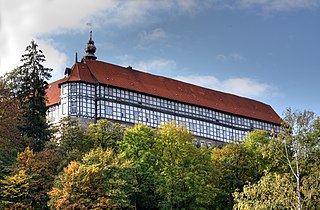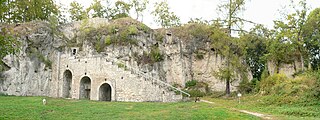
Baron Hermann von Soden was a German Biblical scholar, minister, professor of divinity, and textual theorist.

Pankow are a German rock band, founded in East Berlin in 1981. Their name came from the Berlin district of Pankow, which was once home to most of the officials of the East German government. The band's original lineup consisted of Jürgen Ehle, André Herzberg, Rainer Kirchmann, Jäcki Reznicek and Frank Hille. Other members were Stefan Dohanetz, Ingo York and Jens Jensen.

Bovenden is a municipality in the district of Göttingen, in Lower Saxony, Germany. In 2010 the population in the eight villages belonging to the municipality was 13,350.

The Dębczyn group is an archeological culture in Pomerania from the 3rd to 6th centuries. It was derived from the neighboring Wielbark culture with influences from the Elbe region, and succeeded by migration of West Slavs, the Pomeranian tribes.
The South Harz Railway is a railway line through the German states of Lower Saxony and Thuringia. It runs from Northeim to Nordhausen, via Herzberg am Harz, Bad Lauterberg-Barbis, Bad Sachsa, Walkenried and Ellrich. The line is 69 kilometres (43 mi) long.
Ischenrode is a village in the Gemeinde Gleichen, Göttingen, Braunschweig Bezirk (district), Lower Saxony, Germany.

After the glaciers of the Ice Age in the Early Stone Age withdrew from the area, which since about 1000 AD is called Pomerania, in what are now northern Germany and Poland, they left a tundra. First humans appeared, hunting reindeer in the summer. A climate change in 8000 BC allowed hunters and foragers of the Ertebølle-Ellerbek culture to continuously inhabit the area. These people became influenced by farmers of the Linear Pottery culture who settled in southern Pomerania. The hunters of the Ertebølle-Ellerbek culture became farmers of the Funnelbeaker culture in 3000 BC. The Havelland culture dominated in the Uckermark from 2500 to 2000 BC. In 2400 BC, the Corded Ware culture reached Pomerania and introduced the domestic horse. Both Linear Pottery and Corded Ware culture have been associated with Indo-Europeans. Except for Western Pomerania, the Funnelbeaker culture was replaced by the Globular Amphora culture a thousand years later.
SM UB-35 was a German Type UB II submarine or U-boat in the German Imperial Navy during World War I. The U-boat was ordered on 22 July 1915 and launched on 28 December 1915. She was commissioned into the German Imperial Navy on 22 June 1916 as SM UB-35.
The Gustow group is an archaeological culture of the Roman Iron Age in Western Pomerania. The Gustow group is associated with the Germanic tribe of the Rugii.

Medingen Abbey or Medingen Convent is a former Cistercian nunnery. Today it is a residence for women of the Protestant Lutheran faith near the Lower Saxon town of Bad Bevensen and is managed by the Monastic Chamber of Hanover. The current director of the abbey (Äbtissin) is the art historian Dr Kristin Püttmann.

The Sieber is a 35-kilometre-long, right hand tributary of the Oder in the Harz mountains of Germany.

Herzberg Castle is a German schloss in Herzberg am Harz in the district of Göttingen in the state of Lower Saxony. The present-day, quadrangular building has its origins in the 11th century as a medieval castle. After a fire in 1510 it was rebuilt as a schloss and is one of the few in Lower Saxony that was constructed as a timber-framed building. Because it belonged to the House of Welf for 700 years it is also known as the Welf Castle of Herzberg.

Erbsen is a village in the Flecken Adelebsen in the Landkreis Göttingen in Lower Saxony, Germany. The village has about four hundred inhabitants. It lies some twelve kilometers west of Göttingen on the main road to Adelebsen proper.

SM UB-57 was a German Type UB III submarine or U-boat in the German Imperial Navy during World War I. She was commissioned into the Flanders Flotilla of the German Imperial Navy on 30 July 1917 as SM UB-57.
Franz Friedrich Roger Wilmans was a German historian and archivist.

Elbe-Elster Land, also called the Elbe-Elster region (Elbe-Elster-Gebiet) is a region around the tripoint of the German states of Brandenburg, Saxony-Anhalt and Saxony. It is part of the North German Plain and is named after the two major rivers that have their confluence here: the Elbe and the Black Elster.




















